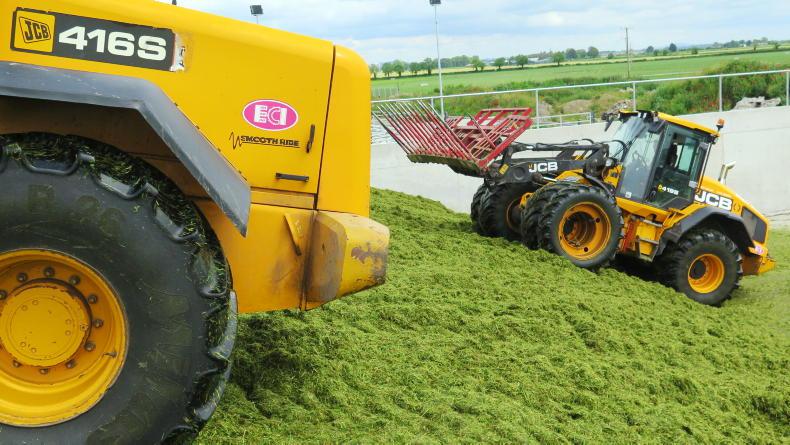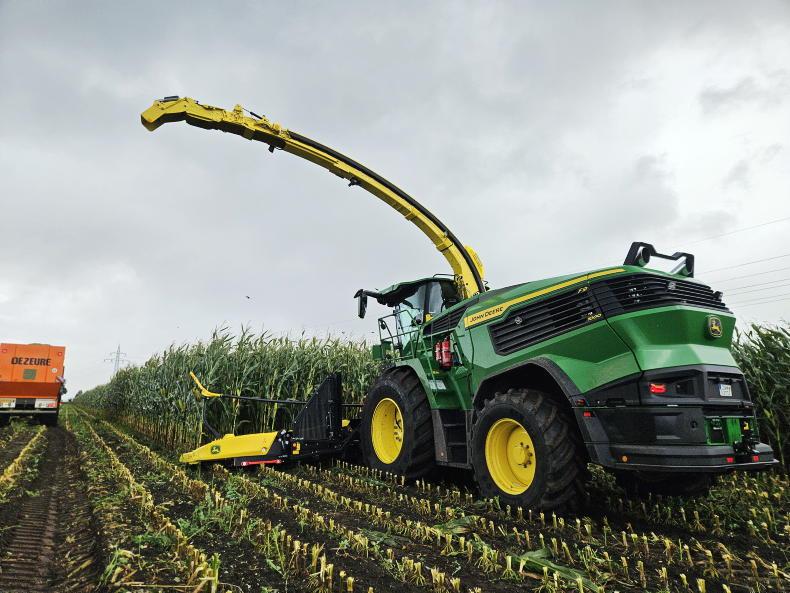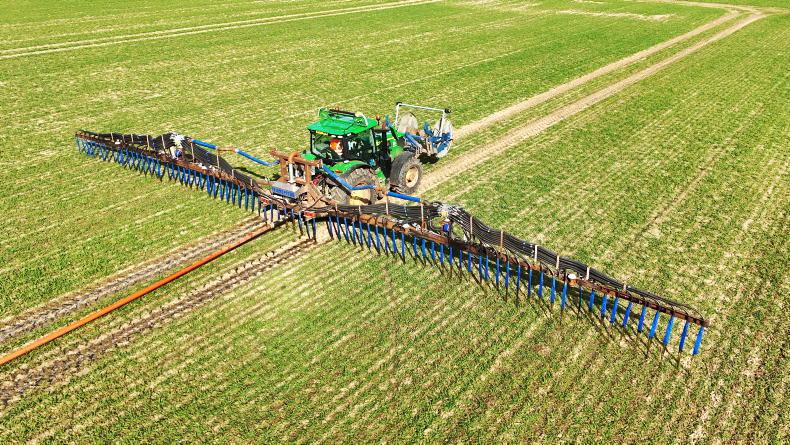For most agricultural contractors, 2023 was a very challenging year, both operationally and financially. This was hugely dictated by poor weather conditions and very significant increases in machinery purchase and repair costs. Two further challenges were the lack of availability of skilled labour and increasing finance costs.
The sector is starting into 2024 faced with continuing poor weather. The sowing of all tillage crops has been significantly delayed – in many cases it’s been impossible, due to wet ground conditions, so from now on it will be a case of panic, with little work done before the start of April.
For contractors who provide services to livestock farmers, 2024 has brought different challenges, mainly around slurry spreading and hedge management.
Ground conditions have again forced contractors into piecemeal, stop-start spreading, where five or six loads are being spread in the most suitable fields. Contractors are having to repeat applications and that includes repeating costly and power-demanding slurry agitation.
New issues
There is a new issue now with late slurry applications using trailing shoes. Some farmers are insisting on reverting to splash plate applications to reduce the likelihood of slurry from dried out trailing shoe lines – presuming we get better weather – being taken in with the silage crops, leading to grass contamination.
The hedge management season has come and gone. Many farmers were unable to get hedges trimmed around electric fences due to the risk of field surface damage. And the National Parks and Wildlife Service are determined that this work is not ‘in the ordinary course of agriculture.’ But what else could it be.
So how is the health of the sector when we look at these challenges? A large number of agricultural contractors are now trading as limited liability companies, and they are obliged to submit their annual returns to the Companies Office. A close examination of the accounts filed for 2022 gives some idea of the health of the agricultural contracting sector, using the solocheck.ie website.
These accounts don’t tell the story of 2023, a far more challenging year. They tell the story of 2022 when milk prices peaked, weather conditions were good, and when plentiful silage and cereal crops were achieved in relatively good conditions. The truth is that 2023 will tell an entirely different story when contractors’ accounts hit the Companies Office over the coming months.

Ground conditions have again forced contractors into piecemeal, stop-start spreading.
For this exercise in examining the financial health of some agricultural contractor businesses we have looked at the accounts of 30 Irish agricultural contractor businesses. We examined each
business based on their abridged accounts for 2022, showing the levels of their tangible assets, current assets minus current liabilities, total liabilities, and their shareholders funds.
Tangible assets are considered to be assets that has a finite monetary value and usually a physical form, such as machinery in the contractor fleet. The
current assets minus current liabilities are a measure of the company’s health simply by subtracting current liabilities from tangible assets.
A company’s total liabilities are the sum of its short and long-term liabilities. In simple terms, liabilities represent the total of a company’s outstanding debt, how much is owed by the company. And lastly, the shareholders’ funds is another term for owners’ or shareholders’ equity. These funds are the amount that shareholders invested in the company plus profits.
Shareholder funds
When we look at the company 2022 accounts of the 30 agricultural contractor companies and compare them with 2021, we find that on average shareholder funds in the sector increased by 15.54%.Most companies did show an improvement in shareholders’ funds, but a small number had a significant drop and that impacted on the average figure.
The average value of tangible assets, machinery values in the sector, only increased by 2.92%, while the total values only increased by 5.63%, reflecting a marginal downward trend of investment in new machinery systems by those contractors.
Among the 30 contractors, the total value of their tangible assets was shown to be over €31 million in 2022.
Looking more closely at total assets minus total liabilities within the sector, we see that the total value of these assets increased by 13.37%, as machinery costs continued to rise. Across the group, their total assets minus current liabilities figure rose from €24 million in 2021 to €27 million in 2022, representing an increase in machinery values.
When we examine the shareholders’ funds figures for the 30 contractors, we find that total shareholder funding rose from €13.9 million to €16.5 million. Five of the group showed lower shareholders’ fund figures in 2022 compared with 2021.
The concern is that the average figures for 2022 showed some declines in terms of shareholder funds while liabilities increased. The situation for 2023 will be more difficult and will reflect the significant financial strain within the agricultural contractor sector.
Coming off the back of a difficult year in 2023, agricultural contractors have not the financial cushion needed for another challenging year in 2024. Farmer spend on contractor services has increased to €7,097 per farm in 2022, up from €5,682 in 2021, a massive 25% increase.
This brings a challenge to manage what is an increase in business turnover, but also potentially an increase in debt management. Contractors need to become more business-like; invoicing regularly is now a priority in order to manage debt at a time of huge machinery and labour cost increases.
Contractors and their farmer clients need to establish payment processes that minimise the cost of debt to the contractor business, using mutually agreed strategies to suit the cash flow needs of both businesses.
Without debt and cash flow management, many agricultural contractor businesses will grind to a halt. And that’s not an attractive outcome especially when auction prices for tractors and farm machinery have started to decline.
Labour costs set to soar
While there is a constant focus on diesel costs among some agricultural and forestry contractors, the bigger but unspoken fear for 2024 is the expected steep increase in labour costs, coupled with a lack of skilled operators in many areas of rural Ireland.
New mandatory costs for small businesses such as agricultural and forestry contractors, have resulted in a steep rise in labour costs at a time of acute labour shortages across the entire agricultural sector.
Mandatory costs
For smaller enterprises such as agricultural and forestry contractors, these new mandatory costs include Statutory Sick Pay (mandatory paid sick days), the auto-enrolment retirement savings system, Parent’s Leave and Parent’s Benefit, the additional public holiday, and the transition to a Living Wage (from the National Minimum Wage (NMW).
There are also planned increases to Pay Related Social Insurance (PRSI) – contributions for employers, employees and the self-employed will be gradually increased between 2024 and 2028.
Combined, these additional costs will result in a 20% rise in labour costs, according to some independent commentators. These mandatory costs will also add to administration costs.
And for agricultural and forestry contractors, these increased labour costs are coming on the back of huge machinery cost inflation.
The net result is that paying a young part-time driver with an existing job and limited tax credits a net figure of €15 per hour will now cost the contractor business close to €25 per hour. These are the level of costs that contractors have to pass on to their farmer clients, in order to be sustainable.
The recent report from the Department of Enterprise, Trade and Employment on ‘The Cumulative Impact of Proposed Measures to Improve Working Conditions in
Ireland’, has confirmed that certain measures will give rise to increased operating costs for some firms over the
coming decade.
This applies particularly to in labour-intensive, relatively low-wage sectors – typically characterised by low margins – such as agricultural and forestry contracting. Where a given firm can’t absorb such costs, these will ultimately feed through to higher prices for consumers and, in this case, higher charges for farmers.
Energy rebates
Some sectors of Irish enterprise have received a cushion in terms of energy cost increases in the form of energy rebates. Not the agricultural and forestry contractor sector.
So, the concern is that these additional labour costs will overwhelm the sector, forcing many contractors into exiting the business. This will leave Irish farming starved of skills and machines to delivery the timely and cost-effective services on which it has now become
utterly dependent.
The Department of Enterprise reports that, in some cases, a firm may opt to re-examine their opening hours and/or the working patterns for their employees, perhaps by reducing average hours worked and/or reducing headcount.
This clearly runs contrary to the realities of the agricultural contracting business, which is seasonal in nature and almost entirely weather-dependent.
Agricultural and forestry contractors were not eligible to take advantage of either the Temporary Business Energy Support Scheme (TBESS) or the Business Users Support Scheme for Kerosene (BUSSK) both of which compensated eligible businesses for higher energy costs.
In the Department report’s heat map of the sectoral impact of improvements to working conditions, it assumes that the Statutory Sick Pay, Public Holidays and Parent Leave/Benefit will have minimal impact in the agricultural sector, while the increase in the Living Wage will have a significant impact.
This is happening at a time when almost 25% of the workforce in agriculture, for which agricultural contracting is included, are earning the minimum wage or less, according to the report.
For most agricultural contractors, 2023 was a very challenging year, both operationally and financially. This was hugely dictated by poor weather conditions and very significant increases in machinery purchase and repair costs. Two further challenges were the lack of availability of skilled labour and increasing finance costs.
The sector is starting into 2024 faced with continuing poor weather. The sowing of all tillage crops has been significantly delayed – in many cases it’s been impossible, due to wet ground conditions, so from now on it will be a case of panic, with little work done before the start of April.
For contractors who provide services to livestock farmers, 2024 has brought different challenges, mainly around slurry spreading and hedge management.
Ground conditions have again forced contractors into piecemeal, stop-start spreading, where five or six loads are being spread in the most suitable fields. Contractors are having to repeat applications and that includes repeating costly and power-demanding slurry agitation.
New issues
There is a new issue now with late slurry applications using trailing shoes. Some farmers are insisting on reverting to splash plate applications to reduce the likelihood of slurry from dried out trailing shoe lines – presuming we get better weather – being taken in with the silage crops, leading to grass contamination.
The hedge management season has come and gone. Many farmers were unable to get hedges trimmed around electric fences due to the risk of field surface damage. And the National Parks and Wildlife Service are determined that this work is not ‘in the ordinary course of agriculture.’ But what else could it be.
So how is the health of the sector when we look at these challenges? A large number of agricultural contractors are now trading as limited liability companies, and they are obliged to submit their annual returns to the Companies Office. A close examination of the accounts filed for 2022 gives some idea of the health of the agricultural contracting sector, using the solocheck.ie website.
These accounts don’t tell the story of 2023, a far more challenging year. They tell the story of 2022 when milk prices peaked, weather conditions were good, and when plentiful silage and cereal crops were achieved in relatively good conditions. The truth is that 2023 will tell an entirely different story when contractors’ accounts hit the Companies Office over the coming months.

Ground conditions have again forced contractors into piecemeal, stop-start spreading.
For this exercise in examining the financial health of some agricultural contractor businesses we have looked at the accounts of 30 Irish agricultural contractor businesses. We examined each
business based on their abridged accounts for 2022, showing the levels of their tangible assets, current assets minus current liabilities, total liabilities, and their shareholders funds.
Tangible assets are considered to be assets that has a finite monetary value and usually a physical form, such as machinery in the contractor fleet. The
current assets minus current liabilities are a measure of the company’s health simply by subtracting current liabilities from tangible assets.
A company’s total liabilities are the sum of its short and long-term liabilities. In simple terms, liabilities represent the total of a company’s outstanding debt, how much is owed by the company. And lastly, the shareholders’ funds is another term for owners’ or shareholders’ equity. These funds are the amount that shareholders invested in the company plus profits.
Shareholder funds
When we look at the company 2022 accounts of the 30 agricultural contractor companies and compare them with 2021, we find that on average shareholder funds in the sector increased by 15.54%.Most companies did show an improvement in shareholders’ funds, but a small number had a significant drop and that impacted on the average figure.
The average value of tangible assets, machinery values in the sector, only increased by 2.92%, while the total values only increased by 5.63%, reflecting a marginal downward trend of investment in new machinery systems by those contractors.
Among the 30 contractors, the total value of their tangible assets was shown to be over €31 million in 2022.
Looking more closely at total assets minus total liabilities within the sector, we see that the total value of these assets increased by 13.37%, as machinery costs continued to rise. Across the group, their total assets minus current liabilities figure rose from €24 million in 2021 to €27 million in 2022, representing an increase in machinery values.
When we examine the shareholders’ funds figures for the 30 contractors, we find that total shareholder funding rose from €13.9 million to €16.5 million. Five of the group showed lower shareholders’ fund figures in 2022 compared with 2021.
The concern is that the average figures for 2022 showed some declines in terms of shareholder funds while liabilities increased. The situation for 2023 will be more difficult and will reflect the significant financial strain within the agricultural contractor sector.
Coming off the back of a difficult year in 2023, agricultural contractors have not the financial cushion needed for another challenging year in 2024. Farmer spend on contractor services has increased to €7,097 per farm in 2022, up from €5,682 in 2021, a massive 25% increase.
This brings a challenge to manage what is an increase in business turnover, but also potentially an increase in debt management. Contractors need to become more business-like; invoicing regularly is now a priority in order to manage debt at a time of huge machinery and labour cost increases.
Contractors and their farmer clients need to establish payment processes that minimise the cost of debt to the contractor business, using mutually agreed strategies to suit the cash flow needs of both businesses.
Without debt and cash flow management, many agricultural contractor businesses will grind to a halt. And that’s not an attractive outcome especially when auction prices for tractors and farm machinery have started to decline.
Labour costs set to soar
While there is a constant focus on diesel costs among some agricultural and forestry contractors, the bigger but unspoken fear for 2024 is the expected steep increase in labour costs, coupled with a lack of skilled operators in many areas of rural Ireland.
New mandatory costs for small businesses such as agricultural and forestry contractors, have resulted in a steep rise in labour costs at a time of acute labour shortages across the entire agricultural sector.
Mandatory costs
For smaller enterprises such as agricultural and forestry contractors, these new mandatory costs include Statutory Sick Pay (mandatory paid sick days), the auto-enrolment retirement savings system, Parent’s Leave and Parent’s Benefit, the additional public holiday, and the transition to a Living Wage (from the National Minimum Wage (NMW).
There are also planned increases to Pay Related Social Insurance (PRSI) – contributions for employers, employees and the self-employed will be gradually increased between 2024 and 2028.
Combined, these additional costs will result in a 20% rise in labour costs, according to some independent commentators. These mandatory costs will also add to administration costs.
And for agricultural and forestry contractors, these increased labour costs are coming on the back of huge machinery cost inflation.
The net result is that paying a young part-time driver with an existing job and limited tax credits a net figure of €15 per hour will now cost the contractor business close to €25 per hour. These are the level of costs that contractors have to pass on to their farmer clients, in order to be sustainable.
The recent report from the Department of Enterprise, Trade and Employment on ‘The Cumulative Impact of Proposed Measures to Improve Working Conditions in
Ireland’, has confirmed that certain measures will give rise to increased operating costs for some firms over the
coming decade.
This applies particularly to in labour-intensive, relatively low-wage sectors – typically characterised by low margins – such as agricultural and forestry contracting. Where a given firm can’t absorb such costs, these will ultimately feed through to higher prices for consumers and, in this case, higher charges for farmers.
Energy rebates
Some sectors of Irish enterprise have received a cushion in terms of energy cost increases in the form of energy rebates. Not the agricultural and forestry contractor sector.
So, the concern is that these additional labour costs will overwhelm the sector, forcing many contractors into exiting the business. This will leave Irish farming starved of skills and machines to delivery the timely and cost-effective services on which it has now become
utterly dependent.
The Department of Enterprise reports that, in some cases, a firm may opt to re-examine their opening hours and/or the working patterns for their employees, perhaps by reducing average hours worked and/or reducing headcount.
This clearly runs contrary to the realities of the agricultural contracting business, which is seasonal in nature and almost entirely weather-dependent.
Agricultural and forestry contractors were not eligible to take advantage of either the Temporary Business Energy Support Scheme (TBESS) or the Business Users Support Scheme for Kerosene (BUSSK) both of which compensated eligible businesses for higher energy costs.
In the Department report’s heat map of the sectoral impact of improvements to working conditions, it assumes that the Statutory Sick Pay, Public Holidays and Parent Leave/Benefit will have minimal impact in the agricultural sector, while the increase in the Living Wage will have a significant impact.
This is happening at a time when almost 25% of the workforce in agriculture, for which agricultural contracting is included, are earning the minimum wage or less, according to the report.











SHARING OPTIONS